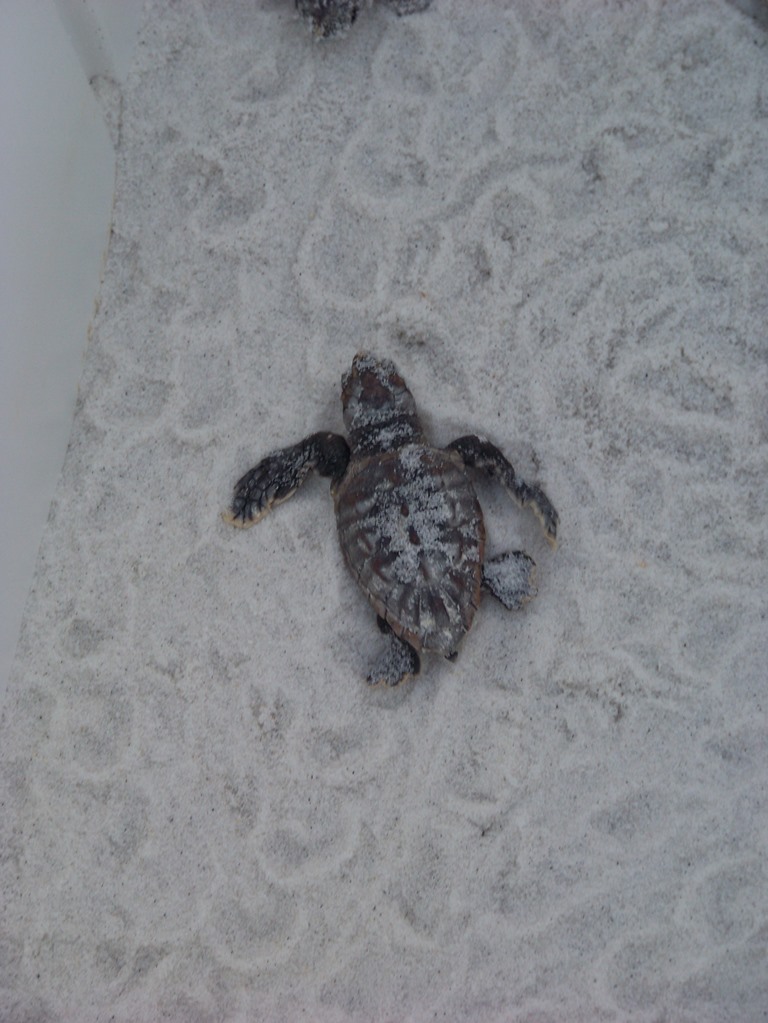
by Rick O'Connor | Nov 4, 2016
October 31st not only reminds all that the ghost and goblins are out and about, but that the sea turtle nesting season is complete for another year. These federally protected animals typically begin nesting in late April and continue into the month of October – but there is almost always someone late to the party…
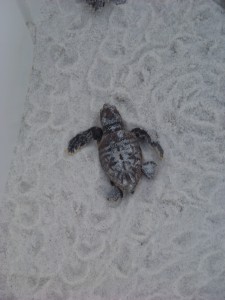
Young loggerhead sea turtle heading for the Gulf of Mexico. Photo: Molly O’Connor
What is neat about sea turtles is that their nesting beaches are usually always in the same general vicinity – meaning Pensacola Beach turtles are Pensacola Beach turtles… each year – and it is always great to see them come back. And this year, come back they did…
I have data collected by Gulf Islands National Seashore going back to 1996. The number of hatching nests on Escambia County beaches has ranged from a low of 8 (2005) to 52 in (2011); it has averaged around 25 hatching nests each year. This year was different…
This year, within the National Seashore, we had a total of 68 nests in Escambia County, 56 of which were on Santa Rosa Island. This is great news!
59 of the 68 nests hatched (87%) – which is also great news – typically only 10-20% of diamond back terrapin nests avoid predators. Most of the sea turtle nests lost this year were due to flooding from tropical storms in the Gulf. There was one nest between Pensacola Beach and Navarre Beach that was raided by a coyote and I am sure there were depredated nests all along the panhandle. But again, between 75-90% of terrapin nests are lost to raccoons, so the sea turtles had a good year. A recent report from southwest Florida states the same – a record nesting season for the Gulf coast.
However, there is still one problem lurking out there… disorientation…
Disorientation occurs when these successful hatchlings emerge from the sand and head the wrong way – typically towards artificial lights. Sea turtles are attracted to shortwave light (blues, greens, and white). Much of our artificial lighting falls into those wavelengths – and attract hatchlings. Since 1996 between 30 – 89% of Escambia County nests have shown signs of disorientation; the average is 49%. This year 63% of the Escambia County nests showed disorientation behavior. We are lucky that we have dedicated turtle watch volunteers to step in and correct these – but they cannot be there for all hatchings – we really need to alter our lighting. Longer wavelengths (yellow and red) do not attract most hatchlings, and therefore – are considered “turtle friendly”. Switching our outdoor lighting to these colors, reducing the illumination, lowering the elevation of the lighting, and shielding the light to direct it towards the ground all help reduce the disorientation problem.
Most panhandle counties have some form of coastal lighting ordinance to address this problem and problems with other wildlife. Ordinances vary some from county to county but the basics are the same; keep it long, keep it low, keep it shielded. Keep it long refers to the wavelength – usually less than 560nm (in the yellow/red portion of the spectrum). Keep low refers the height of the light fixture. If it can be placed at a lower height this is preferred, if not shielding the light source to direct down is required. We must also remember indoor lighting. This can be reduced by simply closing the curtains, moving lamps away from windows, or using tinted windows (if you are replacing yours). Who has to be wildlife friendly varies from county to county, so property owners should contact their Sea Grant Extension Agents if they have questions. There are funds available to help some complete this process and this to varies from county to county.
It’s been a great nesting season, let’s make it even better by reducing the amount of disoriented hatchlings.
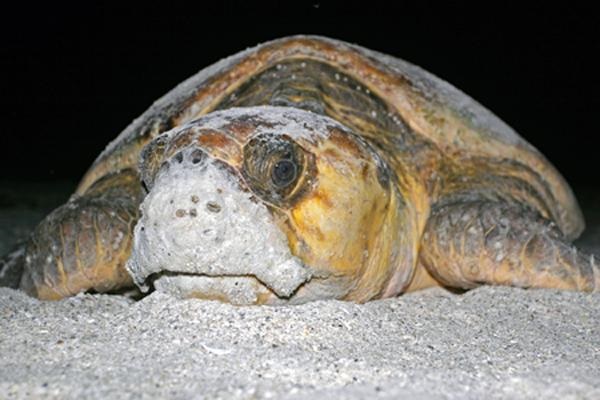
by Rick O'Connor | Aug 26, 2016
It is August, we are just off another successful Sea Turtle Baby Shower event in the Pensacola area, and we are in peak season for sea turtle hatching. Those little guys have a tough road to follow trying to emerge from their nest to reach the open waters of the Gulf of Mexico. Within the nest the young wait for cooler temperatures and no vibrations to begin their climb towards the surface. Once they have emerged, they locate the shortwave light of the moon and stars reflecting off of the water and head for sea. However, ghost crabs, fox, and coyotes, all excavate nests and consume hatchlings running across the sand.

This sea turtle frequents the nearshore snorkel reef at Park East in Escambia County.
Photo: Robert Turpin
But these predators are not alone on Pensacola Beach. Humans have moved onto the island in large numbers. Vehicle tracks, large holes, tents, chairs, and our pets all are obstacles for the young in their journey to the sea. One of the larger problem has been lighting. Most of our buildings are well lit for safety. We tend to use shortwave lighting systems that produce bright white lights similar to what the moon and stars reflect off of the Gulf – many times brighter. Because of this many of the hatchlings will disorient and travel towards the buildings and roads instead of the open Gulf… this certainly is not good. Disoriented turtles will wonder onto road ways where they are hit by cars, and under or around buildings where they can become lost or come in contact with house pets and rats – not to mention the increase time on land will increase the chance of a native predator finding them. If they make it until morning, there is the problem of shorebirds and the sun – the chances of the hatchlings surviving a disorientation are not good.
There are a variety of reasons why sea turtle populations are low enough to have them listed, but this is certain one of the larger problems. Data from Escambia County extending back to 1996 show that, on average, 48% of the sea turtle nests disorient – and it has been as high as 70%.
So What Can We Do to Help the 2017 hatchlings?
First, we are having a big year for nesting. Mark Nicholas, GINS and permit holder for sea turtle work here, indicated there were 101 nests in our area this year… we have a chance to have a really big and successful sea turtle nesting season – with a little help from you.
- Clean the beach before you head in for the night. Most panhandle counties actually have a “Leave No Trace” ordinance which requires the removal of chairs, tents, etc. – but be sure the holes are filled in and the trash is removed as well.
- For inside lighting – turn down the lights and/or close the currents. Exterior lighting should be “turtle friendly” – meaning long wavelength – which means yellow/red. Most panhandle counties have an ordinance for exterior lighting. In Escambia County residents have until 2018 to comply – but we encourage you to make those changes as soon as you can to help the turtles hatching this season. “Turtle Friendly” would include the big three – KEEP IT LOW, KEEP IT LONG, AND KEEP IT SHIELDED. Keep it low meaning as low to the ground as you can. If that is not possible, place a shield on the fixture to direct the light down to where you are walking and not out to the beach. Keep it long refers to the wavelength, longer than 560 nanometers, which is in the yellow/red range of color. Studies show that hatchlings are attracted to the shortwaves (white/blue) end of the spectrum. Having long wave lighting will increase the chances of the hatchling finding the shortwaves from stars off of the Gulf. You will want to keep the illumination down as well. We recommend 25W bulbs, which is bright enough to see and reduces the chance of attracting a young turtle.
- Keep a distance from the marked nests – remember that vibrations (even from your walking) can cause the hatchlings to wait – and waiting too long can cost them their lives. If you are lucky enough to see baby turtles crawling for the Gulf – do not use flash photography and do not use flash lights – unless they have a protective red film producing a low intensity red light.
- If you find a group of hatchlings that are obviously disoriented, contact the local authority in your area. In Escambia County we recommend calling the sheriff substation on the island or the Gulf Breeze dispatch – who will contact the National Park.
If you have questions about turtle lighting options, the current county ordinances designed to help island wildlife, or the Turtle Friendly Beaches program, contact your County Extension Sea Grant Agent.
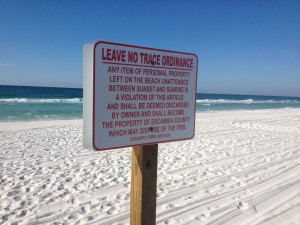
Many counties in the panhandle have lighting and barrier ordinances to protect wildlife and workers.
Photo: Rick O’Connor

by Erik Lovestrand | May 22, 2016
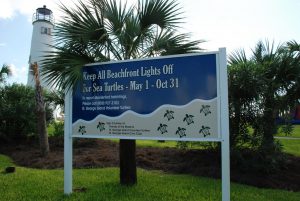
Awareness is Growing!
Photo by: Aprile Clark
That is, when it comes to lights on our homes and businesses near their nesting beaches. Humans have long-known that artificial light can have negative consequences for many nocturnal animals, including nesting and hatching sea turtles. However, it has only been through fairly recent research that we are beginning to understand the reasons behind some of these effects and developing better lighting (or non-lighting) strategies and alternatives to protect our treasured marine turtle species.
Mother sea turtles that nest on Florida Panhandle beaches are “hard-wired” for nighttime activity when it comes to digging their nest cavities and depositing eggs. Likewise, their babies typically leave their sandy nests under cover of darkness, scampering to the Gulf of Mexico. This nocturnal behavior is important for avoiding predators that would have an easy meal of a baby turtle crossing the open beach in the light of day. However, even hatchlings emerging at night face a number of other obstacles. Once in the water there are a many aquatic predators that will not hesitate to gobble up a baby turtle. On average, it is estimated that only about 1 in 1000 babies survive to reach adulthood. With those odds, it would be wise for us to do anything we can to minimize additional threats or hazards during the short but crucial time these marine reptiles spend on the narrow thread of beachfront that we share with them.
One thing we can do involves reducing the disorienting effects of artificial light near our sea turtle nesting beaches. The term “phototactic” is used to describe organisms that are stimulated to move towards or away from light. Nesting females have been shown to avoid bright areas on the beach but hatchlings tend to be attracted to the brightest source of light when they emerge from the sand. On a nesting beach with no artificial lighting, any natural light from the moon or stars is reflected off the water, creating a much brighter horizon in that direction. This naturally attracts the hatchlings in the right direction. Lights from human sources can appear very bright in comparison and quite often draw babies over the dunes and into harm’s way on roadways, from predators, or simply by exposure once the sun comes up.
Many beachfront property owners have learned about this threat and have taken this issue to heart by reducing the amount of light on their property and eliminating or replacing lights visible from the nesting beach with sea turtle-friendly lighting. There are three rules to follow when retrofitting or installing new lighting near the beach.
- Keep it Long: Long-wave-length lighting that is still in the portion of the spectrum visible to humans includes amber, orange and red light. Manufacturers are now making highly efficient LED bulbs that are certified by the FWC as turtle-friendly.
- Keep it Low: Many times lighting needed for safety of access can be placed low enough to be unseen from the nesting beach.
- Keep it Shielded: Fixtures that are in line-of-site to the nesting beach need to be recessed to shield the bulb from being directly visible. The correct long-wave-length bulb should also be used in these shielded fixtures.
Remember, exterior lighting is not the only danger turtles face from our lights. Unobstructed interior lights seen through windows and doors can be just as detrimental. The best solution here is to tint beach-facing glass with a 15% transmittance tinting product. This will save money on cooling bills as well as protect interior furnishings and avoid the possibility that someone in your house might leave the blinds or curtains open accidentally during turtle season. If you have questions regarding turtle-safe lighting practices in Florida there are many resources available through the Fish and Wildlife Conservation Commission the National Marine Fisheries Service, the Sea Turtle Conservancy, and your local UF/IFAS County Extension offices. If you really want to get into the nitty-gritty of turtle lighting and ways to protect turtles check out this FWC publication on assessing and resolving light pollution problems and this model lighting ordinance from UF’s Levin College of Law. Most Florida coastal counties have already adopted sea turtle lighting ordinances so you should also check your local county codes for this issue. Let’s help keep sea turtles in the dark, where they need to be.
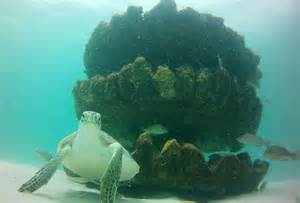
by Laura Tiu | May 8, 2016
Florida has the highest number of sea turtles of any state in the continental US. Three species are common here including loggerhead, green and leatherback turtles. The Federal Endangered Species Act lists all of sea turtles in Florida as either threatened or endangered.
Sea turtle nesting season for the area began May 1, 2016. Adult females only nest every 2-3 years. At 20-35 years old, adult loggerhead and green female turtles return to the beach of their birth to nest. At this age, they are about 3 feet long and 250-300 pounds. The turtles will lay their eggs from May – September, with 50-150 baby turtles hatching after 45-60 days, usually at night. One female may nest several times in one season.
If you happen to see a sea turtle nesting, or nest hatching, stay very quiet, keep your distance, and turn any lights off (no flash photography). You should never try to touch a wild sea turtle. Also, do not touch or move any hatchlings. The small turtles need to crawl on the beach in order to imprint their birth beach on their memory.
During nesting season, it is important to keep the beaches Clean, Dark and Flat. Clean, by removing everything you brought to the beach including trash, food, chairs and toys; dark, by keeping lights off, using sea turtle friendly lighting and red LED flashlights if necessary; and flat, filling up all holes and knocking down sand castles before leaving the beach. If you see anyone harassing a sea turtle or a sea turtle in distress for any reason, do not hesitate to call the Florida Fish and Wildlife Commission hotline at 1-888-404-3922.
There has been encouraging sea turtle news in Florida as a result of the conservation actions being undertaken. There is an increasing number of green turtle nests and a decreasing number of dead turtles found on beaches.
If you want to see a sea turtle and learn more about these fascinating creatures, visit the Navarre Beach Sea Turtle Conservation Center, Navarre, FL, the Gulfarium Marine Adventure Park on Okaloosa Island, Fort Walton Beach, FL, or Gulf World Marine Park in Panama City, FL.
| County |
Beach nesting area (miles) |
Number of loggerhead sea turtle nests |
Number of green sea turtle nests |
Number of leatherback sea turtle nests |
| Franklin |
56 |
608 |
14 |
0 |
| Gulf |
29 |
451 |
14 |
0 |
| Bay |
44 |
170 |
12 |
5 |
| Walton |
30 |
94 |
4 |
3 |
| Okaloosa |
24 |
73 |
6 |
0 |
| Santa Rosa |
7 |
17 |
4 |
0 |
| Escambia |
39 |
86 |
4 |
1 |
Table 1: Data from the 2015 Florida Statewide Nesting Beach Survey available at: www.myfwc.com.

Young loggerhead sea turtle heading for the Gulf of Mexico. Photo: Molly O’Connor
The Foundation for the Gator Nation, An Equal Opportunity Institution.
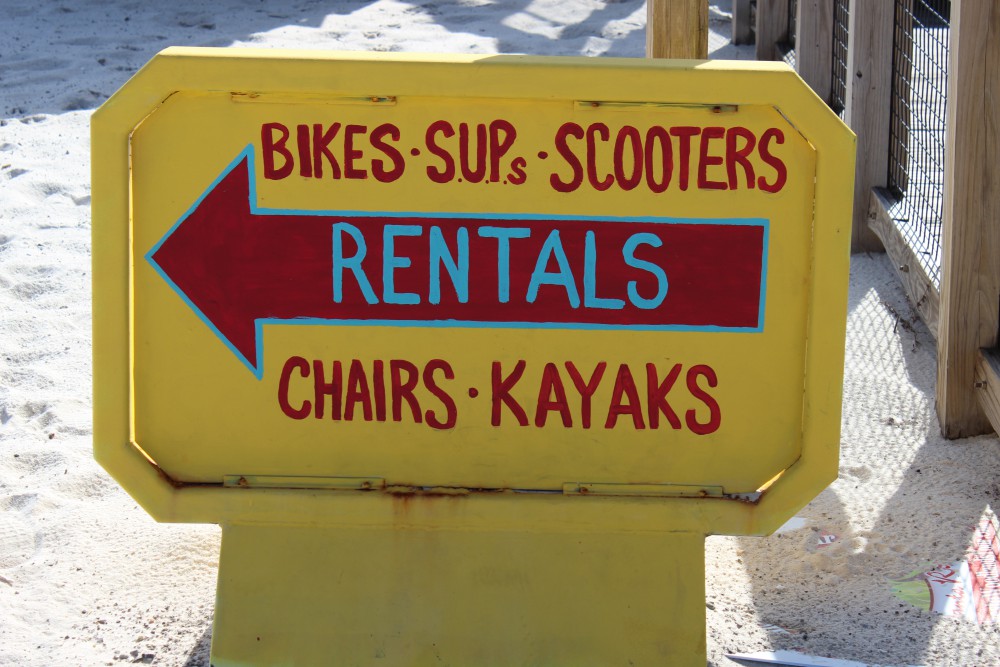
by Rick O'Connor | Mar 25, 2016
All Photos: Molly O’Connor
In this monthly series of highlighting outdoor adventures in the Florida Panhandle, we are visiting locations along the Intracoastal Waterway; from the Alabama State line to the Aucilla River. In January we wrote about Perdido Key, last month we visited Pensacola Beach, this month we move east along Santa Rosa Island to the beach community of Navarre.
Navarre Beach is a relatively quiet community on Santa Rosa Island between Pensacola and Ft. Walton Beach. There are some good places to eat, a new RV campground, and plenty of water/outdoor activities. Navarre Beach became famous in the 1970’s as the location for the film Jaws II. I personally witnessed much of the shooting of the film and it was amazing to see how it all actually all works. The hotel that was used in the film is no longer there but the stories are!
On the Island
There are some great kayak and paddle locations on Navarre Beach. Paddling over the grassbeds and to the east of the Navarre Marine Park you can see a lot of coastal wildlife and great sunsets. You can of course paddle the Gulf as well and maybe take a shot at kayak fishing. You will find local kayak rentals and guides by visiting Naturally EscaRosa website.
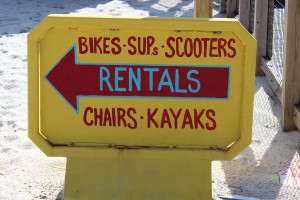
Paddling in a kayak or on a paddleboard is a great way to view wildlife and natural scenes while visiting Navarre Beach.
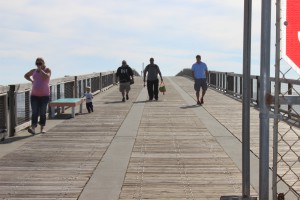
The Navarre Fishing Pier extends over 1500 feet. Not only a great place to fish but a great place to view marine life.
Speaking of fishing, there is the Navarre Beach Fishing Pier which extends 1500 feet out over the Gulf. The pier provides of variety of price options for fishermen of all ages and for $1 you can just walk and enjoy the view. Sharks and sea turtles are often seen from here – and don’t forget the sunsets.
There are two educational interpretive centers on Navarre Beach. The Navarre Beach Marine Science Station is part of the Santa Rosa County School District. They provide programs for elementary, secondary, and dual-enrolled high school-college students. The Station also provides numerous youth camps during the school year and during the summer, as well as providing activities at local community events. To see if they have something going for your young one while you are here visit their website.
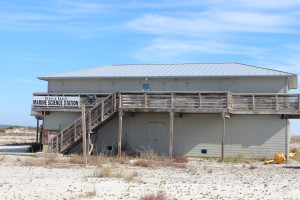
The Navarre Beach Marine Science Station provides education for young and old.
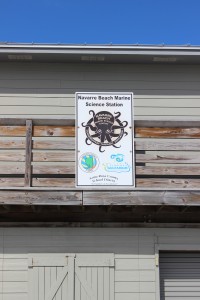
The Navarre Beach Sea Turtle Conservation Center is an educational center that focuses on imperiled marine wildlife but the sea turtle is the star of the show. The center will eventually house an injured sea turtle that can no longer be released but until one arrives, there is plenty to see and learn. Learn more about the center at their website.

The Navarre Beach Sea Turtle Conservation Center.
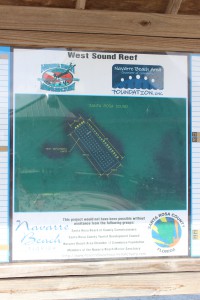
Santa Rosa County also provides a couple of nearshore snorkel reefs for the public. You can find them on both the Gulf and Sound sides.
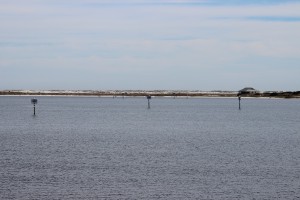
These day markers are marking two nearshore snorkel reefs on the Sound side of Navarre Beach. They can be accessed from the Navarre Marine Park.
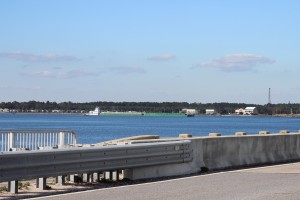
A barge travels beneath the Navarre Beach Bridge as it heads east along the ICW.
Off the island
Actually, you have to leave Santa Rosa at this point. The island between Navarre Beach and Ft. Walton Beach is the property of the United States Air Force.
As you leave Navarre Beach to travel the ICW from the north side, you see the Panhandle Butterfly House on your left at the Highway 98 traffic light. This is a great stop. Viewing live butterflies feeding on native plants in all stages of their lives is a cool sight. There are plenty of volunteers to educate you about native butterflies and there is a pond out back with a lot of turtles and birds to view. It’s a neat and relaxing place.
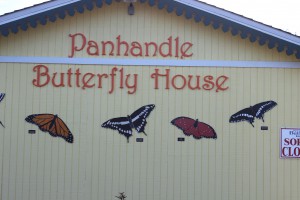
The Panhandle Butterfly House is located just to the west of the traffic light on Highway 98 as you leave Navarre Beach.

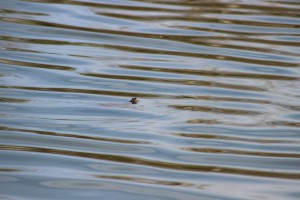
Numerous turtles can be found swimming and basking in the pond behind the butterfly house.
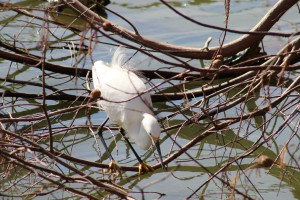
A snowy egret hunts for a meal in the turtle pond behind the butterfly house.
Nature Notes: Sea Turtles
Who doesn’t love sea turtles! These silent, charismatic creatures have been navigating Gulf waters, and nesting on our beaches for centuries. Certainly the largest species of turtle humans will encounter, weighing in between 200-300 pounds – with some reaching 1000 pounds, they are an awesome thing to see. There are five species found in the northern Gulf of Mexico and there are records of four them nesting here. Those species are the Loggerhead, Green, Kemp’s Ridley, Hawksbill, and the giant of them all the Leatherback.
Sea turtles begin their lives within the egg buried on a beach. The sex of the embryo is determined by the temperature of the sand they are incubating in – cold ones become males and 29°C appears to be the cutoff. After 60-70 days incubating the young hatchlings emerge at night and orient towards shortwave light (moon or stars off the water). However, in recent years much of the light we provide in our homes as directed them in the wrong direction (disorientation). There are “turtle friendly lights” that use longwave colors and significantly reduce the disorientation problem. All coastal counties along the panhandle require these lights for island structures. Many of the hatchlings are lost as they wonder to the Gulf. Ghost crabs, fox, coyotes, and now feral cats capture and consume many.
Those lucky enough to reach the water now have to deal with fish and bird predators. These young head offshore seeking the Sargassum mats where they will spend their growing years feeding and hiding.
As immature adults most species will return to the coastal areas to feed on seagrasses or invertebrates. As they become sexually mature they, once again, head to sea. Though they travel far and wide they are known to return to their place of birth for breeding and egg laying. Breeding takes place just offshore and females may come ashore more than once to deposit their clutch of 100+ eggs.
In addition to light pollution, marine debris, boat strikes, commercial fishing nets, and even holes and chairs left on the beach overnight have caused their numbers to decline. You should be aware that most coastal counties have a “leave no trace” ordinance asking you to remove your chairs, tents, and other items at the end of the day – and please fill in any holes you may have dug. All species of marine turtles are currently listed and protected by the U.S. Fish and Wildlife Service. In Florida, the USFWS has yield management of these species to the Florida Fish and Wildlife Conservation Commission. They are truly a magnificent creature and we hope all get to see one while exploring our beaches.
Now it is time to move to Okaloosa County – the April issue will look at Ft. Walton and Destin. Let’s head there and see what cool outdoor adventures await us.
You can find information on ecotourism providers in Escambia and Santa Rosa counties by visiting Naturally EsacRosa.




















